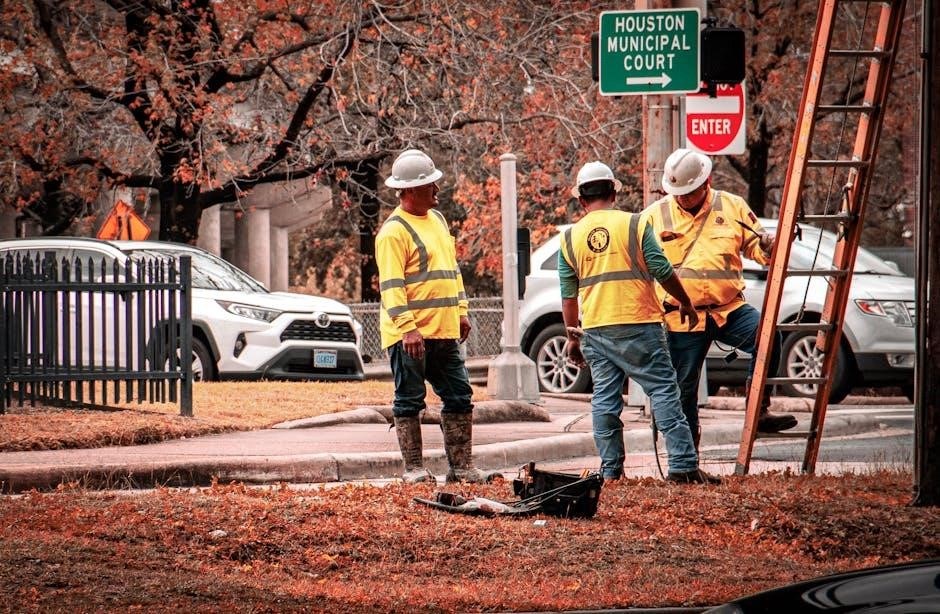The Lewis and Clark Guide Service honors the historic expedition led by Meriwether Lewis and William Clark, exploring the Louisiana Purchase and Pacific Northwest. It offers educational programs, historical reenactments, and guided tours, promoting the expedition’s legacy and significance in American history.
1.1 Historical Background of the Lewis and Clark Expedition
The Lewis and Clark Expedition, also known as the Corps of Discovery, was a U.S. military expedition that began in 1804. Led by Capt. Meriwether Lewis and Lieut. William Clark, it aimed to explore the newly acquired Louisiana Purchase and the Pacific Northwest. Commissioned by President Thomas Jefferson, the expedition was driven by scientific curiosity and the desire to map the western territories. Jefferson’s lifelong interest in the West and its potential for expansion motivated the journey. The expedition marked a significant chapter in American history, laying the groundwork for westward expansion and contributing to the nation’s understanding of its vast natural resources and indigenous cultures.

1.2 Purpose of the Lewis and Clark Guide Service
The Lewis and Clark Guide Service is dedicated to preserving and sharing the legacy of the historic expedition. Its primary purpose is to educate the public about the journey, its significance, and its impact on American history. By offering guided tours, educational programs, and historical reenactments, the service aims to connect people with the natural and cultural landscapes explored by Lewis and Clark. It also seeks to inspire a deeper appreciation for the expedition’s contributions to science, cartography, and westward expansion. The guide service serves as a bridge between the past and present, fostering a sense of adventure and discovery while honoring the expedition’s enduring legacy.

Key Members of the Lewis and Clark Expedition
Meriwether Lewis, William Clark, and Sacagawea were pivotal figures, leading the expedition with leadership, navigation, and cultural bridging, shaping its historic success and legacy.
2.1 Meriwether Lewis: Leader and Organizer
Meriwether Lewis was the primary leader and organizer of the expedition, appointed by President Thomas Jefferson. A skilled military officer and naturalist, Lewis prepared meticulously for the journey, overseeing logistics, supplies, and equipment. His deep knowledge of wilderness survival and diplomacy proved crucial. Lewis documented discoveries, collected scientific specimens, and maintained detailed journals, which became invaluable historical records. His leadership ensured the expedition’s success, navigating uncharted territories and fostering relations with Native American tribes. Lewis’s organizational skills and vision laid the foundation for the expedition’s achievements, solidifying his legacy as a pivotal figure in American exploration and history.
2.2 William Clark: Co-Leader and Cartographer
William Clark was the co-leader of the expedition and a skilled cartographer, responsible for mapping the territories they explored. His detailed charts and journals provided critical information for future settlers and explorers. Clark’s ability to navigate and document the expedition’s route was instrumental in its success. He also played a key role in interactions with Native American tribes, fostering peaceful relations and gathering essential cultural knowledge. Clark’s cartographic skills and leadership complemented Meriwether Lewis’s organizational abilities, making him an indispensable partner in the journey. His contributions to mapping the western territories remain a cornerstone of American historical and geographical knowledge.
2.3 Sacagawea: The Indigenous Guide
Sacagawea, a Shoshone woman, played a pivotal role as a guide and interpreter for the Lewis and Clark Expedition. Her knowledge of the Western wilderness and ability to communicate with Native American tribes were indispensable. Accompanying the expedition with her infant son, Jean Baptiste, she facilitated peaceful interactions and navigation. Sacagawea’s linguistic skills and cultural insights were crucial in negotiations and gathering information. Her contributions went beyond guiding; she bridged cultural gaps and fostered understanding. Despite her significant impact, her life post-expedition is less documented, yet her legacy remains as a symbol of resilience and cultural connection in American history.

The Journey and Its Significance
The Lewis and Clark Expedition marked a pivotal moment in U.S. history, exploring vast territories and mapping geography. It facilitated westward expansion and established trade routes, shaping the nation’s future.
3.1 The Louisiana Purchase and Its Exploration
The Louisiana Purchase of 1803 doubled the size of the United States, adding over 828,000 square miles of land west of the Mississippi River. This monumental acquisition sparked the need for exploration to map the vast, unknown territory. President Thomas Jefferson, who orchestrated the purchase, commissioned the Lewis and Clark Expedition to explore this newly acquired land. The expedition aimed to chart the region’s geography, identify natural resources, and establish trade with Native American tribes. This effort not only expanded U.S. sovereignty but also laid the foundation for westward expansion. The Louisiana Purchase and its subsequent exploration remain pivotal in shaping America’s geographic and cultural identity.
3.2 The Route of the Expedition
The Lewis and Clark Expedition followed a well-planned route that spanned over 7,000 miles. Departing near St. Louis in 1804, they traveled up the Missouri River, documenting its tributaries and natural features. The journey included portaging around the Great Falls of Montana, a challenging 18-mile stretch. They crossed the Continental Divide at Lemhi Pass and followed the Columbia River to the Pacific Ocean, reaching the coast in November 1805. The return trip in 1806 retraced their path, with some variations, ensuring a comprehensive exploration of the region. This meticulously charted route provided invaluable geographic and cultural insights, shaping the understanding of the western territories.
3.3 Major Discoveries and Contributions
The Lewis and Clark Expedition yielded significant discoveries and contributions to American history and science. They identified over 100 new plant and animal species, expanding biological knowledge. The expedition mapped the Missouri River and its tributaries, providing critical geographic data. Their encounters with Native American tribes facilitated cultural exchanges and established diplomatic relations. The journey demonstrated the feasibility of reaching the Pacific by land, influencing westward expansion. Lewis and Clark’s detailed journals and maps became invaluable resources for future explorers and settlers. Their findings also sparked scientific curiosity, shaping early American natural history studies. This expedition laid the foundation for the development of the western United States.

The Journals of Lewis and Clark
Lewis and Clark meticulously documented their expedition in journals, recording daily events, geographical observations, and encounters with Native American tribes, providing invaluable historical and scientific insights.
4.1 Content and Details of the Journals
The journals of Lewis and Clark are a comprehensive record of their expedition, detailing daily events, geographical observations, and interactions with Native American tribes. They meticulously documented new species, geological formations, and botanical discoveries, providing rich scientific data. The journals also include detailed maps and sketches, showcasing Clark’s cartographic skills. Personal reflections and challenges faced by the team are also noted, offering insights into the human aspects of the journey. These writings serve as a primary source for understanding the expedition’s significance, blending scientific inquiry with historical narrative. Their collaborative effort ensured a well-rounded account of the voyage, preserving invaluable knowledge for future generations.
4.2 Importance of the Journals for Modern Research
The journals of Lewis and Clark are invaluable for modern research, offering unparalleled insights into early 19th-century American history, ecology, and culture. They provide detailed accounts of previously unexplored territories, documenting flora, fauna, and geological features. Historians rely on these records to understand the context of westward expansion and its impact on Native American communities. Ecologists use the data to study environmental changes over time, while ethnographers analyze the interactions with indigenous tribes. Additionally, the journals serve as a foundation for historical reenactments and educational programs, preserving the expedition’s legacy for future generations. Their meticulous documentation remains a cornerstone of interdisciplinary research and historical preservation.

Natural History Discoveries
The Lewis and Clark expedition uncovered numerous natural history discoveries, including new species, geological formations, and diverse ecosystems, significantly expanding scientific knowledge of the American West.
5.1 New Species Documented During the Expedition
Lewis and Clark’s journey led to the discovery of numerous new species, including the prairie dog, which they described in detail. They documented various plants, animals, and birds previously unknown to Eastern scientists. These discoveries expanded biological knowledge and provided insights into the region’s biodiversity.
5.2 Geological and Botanical Findings
The Lewis and Clark Expedition uncovered significant geological and botanical discoveries, enhancing understanding of the Western wilderness. They documented unique rock formations, mineral deposits, and soil types, which later aided in mapping the region. Botanically, they identified over 100 plant species, including the cottonwood tree, which became vital for crafting canoes. These findings were meticulously recorded in their journals, providing early scientific insights into the region’s natural resources. Their discoveries laid the foundation for future geological and botanical studies, highlighting the expedition’s enduring contributions to scientific knowledge and exploration.
5.3 Impact on Scientific Knowledge
The Lewis and Clark Expedition significantly advanced scientific knowledge by documenting previously unknown species, geological formations, and ecological systems. Their discoveries of new plants and animals expanded biological classifications, while their observations of landscapes and natural resources provided foundational data for future geological studies. The expedition’s detailed records of Native American uses of plants and natural remedies added to ethnobotanical knowledge. These findings not only enriched scientific understanding but also laid the groundwork for later explorers and researchers. The expedition’s contributions remain vital in fields like ecology, geography, and natural history, underscoring its enduring legacy in shaping scientific exploration and education.

The Legacy of Lewis and Clark
The Lewis and Clark Expedition’s legacy endures through its pivotal role in westward expansion, shaping America’s development and inspiring future explorers and educational endeavors and historical studies.
6.1 Historical Impact on Westward Expansion
The Lewis and Clark Expedition significantly influenced westward expansion by mapping uncharted territories, identifying natural resources, and establishing trade routes with Native American tribes. Their findings, documented in detailed journals, provided crucial information for future settlers and policymakers. The expedition’s success validated the Louisiana Purchase, encouraging further U.S. expansion. It also laid the groundwork for the concept of Manifest Destiny, shaping America’s identity and ambition. The discovery of new lands and resources spurred migration, economic growth, and the development of infrastructure. Their journey remains a cornerstone in American history, symbolizing exploration, resilience, and the pursuit of discovery that defined the nation’s early growth and identity. The expedition’s legacy continues to inspire modern-day explorers and historians alike, ensuring its impact endures for generations.
6.2 Cultural and Educational Significance Today
The Lewis and Clark Expedition holds profound cultural and educational significance in modern times. Their journey is celebrated as a symbol of exploration, resilience, and collaboration, inspiring countless educational programs, documentaries, and museum exhibits. Schools across the U.S. incorporate their story into history curriculums, emphasizing themes of discovery, cultural exchange, and environmental awareness. Additionally, reenactments and living history events bring their adventure to life, engaging audiences and fostering a deeper connection to American heritage. Their legacy also highlights the importance of teamwork and diversity, as the expedition relied on contributions from individuals of various backgrounds, including Sacagawea and other Indigenous guides. This enduring relevance ensures their story continues to educate and inspire future generations, offering timeless lessons in exploration, adaptability, and cultural understanding.

Challenges Faced by the Expedition
The Lewis and Clark Expedition faced numerous challenges, including harsh weather, treacherous terrain, and limited supplies, which tested their resilience and survival skills daily.
7.1 Geographic and Environmental Obstacles
The Lewis and Clark Expedition encountered significant geographic and environmental challenges, including rugged terrain, dense forests, and treacherous river crossings. The Rocky Mountains posed a major hurdle, requiring the team to navigate steep trails with heavy equipment. Harsh weather conditions, such as extreme cold, snowstorms, and heatwaves, further complicated their journey. Additionally, the vast, uncharted wilderness meant constant uncertainty, with the risk of getting lost or encountering unanticipated natural hazards. The Missouri River, while crucial for travel, often proved dangerous due to strong currents and unpredictable water levels. These obstacles tested the explorers’ endurance, navigation skills, and ability to adapt to unpredictable environments.
7.2 Interactions with Native American Tribes
During their expedition, Lewis and Clark interacted with numerous Native American tribes, encountering both cooperation and tension. Sacagawea played a pivotal role in facilitating communication, particularly with the Shoshone, aiding in the acquisition of horses. Many tribes were curious about the expedition’s purpose, leading to discussions about trade and territorial intentions. While some interactions were peaceful, others were strained, with misunderstandings and mistrust arising. The expedition’s reliance on Native American knowledge and resources highlighted the complex dynamics of their relationships. These encounters significantly influenced the expedition’s success and left a lasting impact on the tribes involved, shaping the course of U.S. westward expansion.
7.3 Logistical and Supply Challenges
The Lewis and Clark expedition faced significant logistical and supply challenges during their journey. Maintaining adequate food supplies was a constant struggle, with spoilage and limited resources often causing shortages. The corps relied on hunting and trading with Native American tribes to supplement their provisions. Transportation posed another hurdle, as the heavy keelboat and canoes required portaging around treacherous river segments. Weather conditions, such as harsh winters and flooding, further complicated supply management. Additionally, the expedition had to ensure the health and morale of the party, which was no small feat given the physical demands and isolation of the journey. These challenges tested their resilience and planning abilities throughout the expedition.

The Role of Guides and Porters
Guides and porters were essential to the expedition’s success, providing navigation expertise, language translation, and logistical support. Their local knowledge and physical labor ensured the corps’ survival and progress.
8.1 Sacagawea’s Role as a Guide
Sacagawea, a Shoshone woman, played a pivotal role as a guide and interpreter for the Lewis and Clark Expedition. Her knowledge of the Western terrain and languages facilitated navigation and diplomacy with Native American tribes. She helped identify edible plants and safe passages, crucial for survival. Sacagawea’s presence also eased interactions with indigenous peoples, as her infant son symbolized peaceful intentions. Her leadership and insights were instrumental in overcoming geographic challenges and fostering trust. Without her contributions, the expedition’s success would have been greatly diminished. Sacagawea’s legacy endures as a symbol of resilience and cultural bridge-building, making her an indispensable figure in American exploration history.
8.2 Contributions of Other Guides and Porters
Beyond Sacagawea, other guides and porters played vital roles in the Lewis and Clark Expedition. York, William Clark’s enslaved man, contributed significantly, though his role is less documented. George Drouillard, a skilled hunter and interpreter of mixed French and Native American heritage, was instrumental in negotiations and obtaining horses. The expedition also relied on a team of boatmen who navigated the treacherous rivers and managed the heavy canoes. Additionally, local guides from various Native American tribes provided crucial knowledge of the terrain and resources. Their collective efforts ensured the expedition’s progress, highlighting the importance of diverse skills and cultural expertise in overcoming the challenges of the journey.

Modern-Day Applications of the Guide Service
The Lewis and Clark Guide Service inspires educational programs, historical reenactments, and cultural tours, fostering a deeper connection to American history and wilderness exploration.
9.1 Educational Programs Inspired by the Expedition
Educational programs inspired by the Lewis and Clark Expedition focus on history, science, and survival skills. These programs often include field trips, classroom activities, and hands-on experiences that recreate the expedition’s challenges. Students learn about cartography, natural history, and cultural interactions, fostering critical thinking and teamwork. Many schools incorporate the expedition’s journals into curricula, allowing students to analyze primary sources. Additionally, living history events and reenactments bring the expedition to life, engaging learners of all ages. Such programs not only teach historical significance but also promote an appreciation for exploration and environmental stewardship, aligning with the expedition’s enduring legacy.
These initiatives inspire curiosity and a deeper connection to America’s past.
9.2 Historical Reenactments and Tours
Historical reenactments and tours inspired by the Lewis and Clark Expedition bring the journey to life for modern audiences. These events often feature actors portraying the explorers, interactive exhibits, and guided hikes along the original route. Participants can experience the challenges of frontier travel, such as navigating rivers and hiking rugged terrain. Many tours visit key landmarks like the Continental Divide and the Columbia River. Period-accurate costumes, gear, and activities create an immersive experience, helping visitors connect with the expedition’s history. These events not only entertain but also educate, fostering a deeper appreciation for the expedition’s significance in American history.
Such reenactments honor the legacy of Lewis and Clark while engaging communities in their story.
The Lewis and Clark Guide Service encapsulates the expedition’s enduring legacy, offering insights into history, culture, and exploration. Its significance remains vital for education and inspiration.
10.1 Summary of the Lewis and Clark Guide Service
The Lewis and Clark Guide Service serves as a comprehensive resource dedicated to the historic expedition led by Meriwether Lewis and William Clark. It provides detailed insights into their journey, discoveries, and the lasting impact of their exploration. The guide highlights the expedition’s significance in shaping U.S. history, including the Louisiana Purchase and westward expansion. It also emphasizes the crucial roles of key figures like Sacagawea and the challenges faced during the voyage. The service offers educational programs, historical reenactments, and modern applications, ensuring the legacy of Lewis and Clark remains relevant today. It bridges the past with the present, inspiring future generations to explore and learn.
10.2 Final Thoughts on Its Importance
The Lewis and Clark Guide Service holds profound historical and cultural significance, offering insights into the exploration and development of the American West. Their journey not only expanded geographical knowledge but also laid the foundation for future scientific and cultural advancements. Today, their legacy inspires educational programs, historical reenactments, and a deeper appreciation for the region’s natural and indigenous heritage. The guide service serves as a bridge between the past and present, reminding us of the importance of exploration, collaboration, and respect for the environment. Their story continues to captivate audiences, ensuring that the spirit of discovery remains alive for generations to come.

Leave a Reply